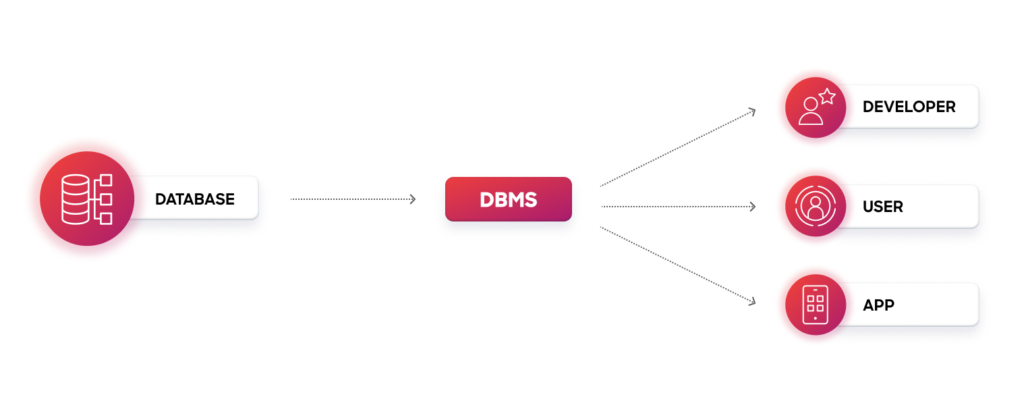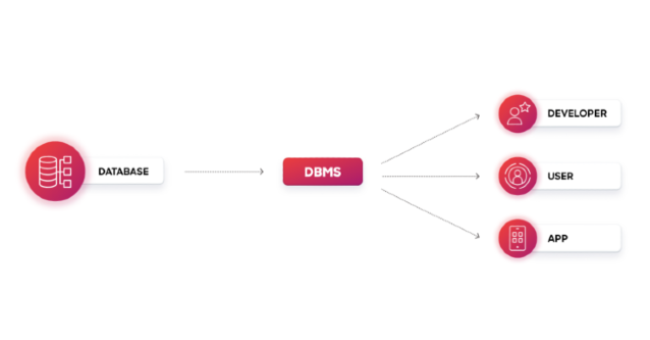As the volume of critical business data increases, so does the need for a database management system (DBMS), which helps orchestrate large quantities of information.
A DBMS improves your data processes and increases the business value of your company’s data assets, freeing users in a wide variety of roles from repetitive and time-consuming data processing tasks.
The result? A more productive workforce, better compliance with data regulations, and better data-driven decisions.
What is a Database Management System (DBMS)?

A database management system (DBMS) is advanced software designed for managing and retrieving large amounts of data. A DBMS sits on top of a data storage system, giving users the ability to create, update, and query databases.
A database management system also provides tools to administer the database schema, which dictates the structure of the database itself. In many cases, the database management system will be seen only by the database developer, because the developer will provide a different front end for the customer. There are several types of DBMS, distinguished by the ways data is stored and the programming languages used to query the database. A DBMS can be accessed by users, applications, or other database management systems. A DBMS can also be used to interact with and manage data in a variety of storage systems, including cloud storage, infrastructure as a service, or on-premise systems. The advanced querying capabilities of a DBMS allow businesses to derive meaningful insights, which fosters better partnerships, enhances customer relationships, and drives profitability.
In a highly competitive business landscape, having an efficient DBMS can be the difference between staying ahead or falling behind — and the ability of your DBMS to support the systems that make a modern go-to-market approach possible is a key factor in deciding whether a DBMS is right for any given business.
How Does a DBMS Differ From a Traditional File Management System?
Unlike a traditional file management system, where data is stored in individual files, a DBMS centralizes data storage, making data management more efficient and structured. This centralized approach allows for sophisticated data modeling, better data integrity, and reduced data redundancy.
With a DBMS, data can be fetched using complex queries, allowing for precise data extraction based on multiple criteria. Traditional file systems, on the other hand, require manual searching and filtering, which can be time-consuming and susceptible to errors. The querying capabilities of a DBMS make sure data retrieval is not only faster, but also more accurate and consistent.
Benefits of a DBMS
1. Improved data sharing and data security
2. Effective data integration
3. Consistent, reliable data
Related resource: How to Evaluate and Measure the Quality of Your Data Download the eBook
4. Compliance with privacy regulations
5. Increased productivity
A good DBMS empowers people to spend more time on high-value activities and strategy instead of spending time manually scrubbing lists.
6. Better decision-making
A DBMS helps provide a framework to make data quality initiatives easier. After all, better data management procedures generate higher-quality information, which leads to better decision-making.
What Are the Main Types of Database Management Systems?
These are some of the more common DBMS types:
Relational Database Management System (RDBMS)
Think of an RDBMS like a set of tables. Each table has rows and columns, similar to a spreadsheet. The tables are related to each other, which means data from one table can be connected with data from another table. Examples of this type of DBMS include MySQL, Oracle, and Microsoft SQL Server.
Hierarchical Database Management System
Imagine a family tree — a structure that starts at the top and branches out. A hierarchical database management system stores data in a tree-like format, with “parent” and “child” structures connecting the data. IBM’s Information Management System, originally developed in the 1960s, is a core example of this kind of DBMS.
Network Database Management System
Instead of a tree-like structure, a network database management system has a flexible web of connections. It’s similar to the hierarchical type but allows more complex relationships between data points. Another older database model, examples of this kind of DBMS include Raima Database Manager and the Oracle CODASYL DBMS.
Object-Oriented Database Management System (OODBMS)
Think of an OODBMS as a collection of objects. These objects are like containers that hold both data and the instructions for what you can do with that data. It’s a bit like combining a database with programming. IntersSystems Cache and Actian NoSQL are highly rated examples of DBMS used for object-oriented databases.
NoSQL Database Management System
Unlike the structured tables in a relational system, NoSQL databases allow for a variety of data models, including key-value, document, columnar, and graph formats. This database type is suitable for big data and real-time applications. Some examples of NoSQL databases include MongoDB and Cassandra.
Flat File Database
Think of a flat file database as a single table. It’s a basic system where data is stored in a plain text file. It’s simple and doesn’t have the fancy features like the others, but it’s great for small tasks.
What Components are Included in a DBMS?
At its core, a DBMS is an intricate ensemble of tools and languages designed to handle, maintain, and retrieve data with efficiency and security. Let’s dive deep into the components that typically make up a DBMS:
Data stores: This is where the actual data resides. Think of data stores as warehouses for data, storing information in a systematic manner, allowing for swift retrieval.
Data storage: While ‘data stores’ refers to the place or medium where data is kept, ‘data storage’ emphasizes the mechanism and format by which data is saved within those stores. This can range from traditional disk-based storage to more modern and scalable cloud storage solutions.
Multi-user access: One of the strengths of a DBMS is its ability to support simultaneous access by multiple users. Whether it’s a team of analysts querying data at the same time or different departments entering and updating records, a DBMS is equipped to handle concurrent user access efficiently.
Data retrieval: This is a foundational capability of a DBMS. Using various querying data methods, users can fetch specific data from the system with ease and precision.
Access control: Security is paramount in data management. A DBMS provides robust access control mechanisms, ensuring that only authorized individuals can view, modify, or delete specific sets of data.
Data querying: Querying is the art and science of asking questions of your data. A DBMS provides users with tools, often SQL-based, to craft queries that return precise information based on specific criteria.
Transaction management: A DBMS often includes a transaction management subsystem to ensure that the database remains in a consistent state even in case of system failures. This includes mechanisms for rollback, commit, and handling concurrent transactions.
Metadata repository: A DBMS includes a data dictionary or metadata repository that contains information about the structure, format, relationships, constraints, and other characteristics of the data in the system.
Indexing and hashing: For quicker data retrieval, a DBMS will typically include indexing and hashing capabilities. These tools create a data structure that improves the speed of data retrieval operations on a database.
Backup and recovery: Data protection is crucial for any business. A DBMS typically includes tools for backing up data and restoring it in case of a failure.
Get Serious About the Data in Your Database
Whether you’re pulling insights from a hierarchical database or enforcing strict access control protocols, a DBMS is an essential tool for modern businesses.
For companies moving toward modern GTM models of sales, marketing, and customer support, it’s vital to have a DBMS that can support and interact reliably with the most advanced data management tools on the market.
At ZoomInfo, our best-in-class B2B data and orchestration systems are the fuel for a DBMS that delivers bottom-line results for business. To ensure your DBMS is ready for a modern GTM approach, it’s important to ensure the system has enough performance, scalability, customization, and flexibility to keep up with the speed of today’s business users.
To find out more about how ZoomInfo can your company uncover insights, engage customers, and win faster, reach out to a data specialist today.


